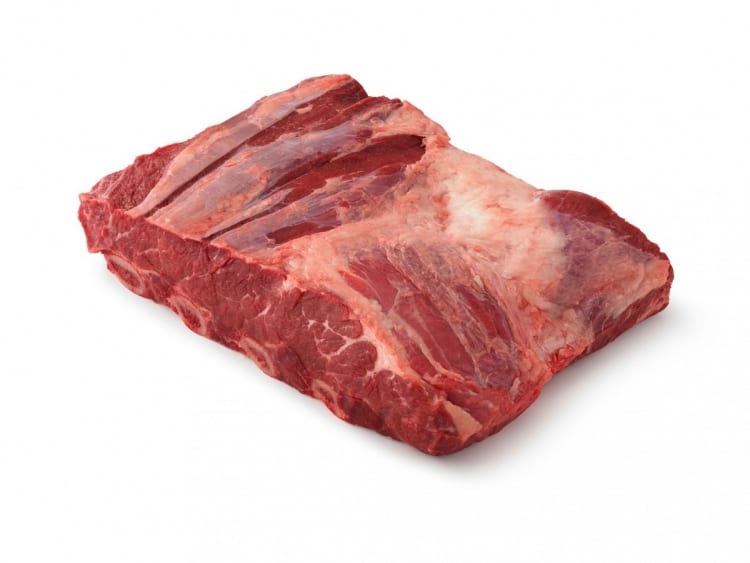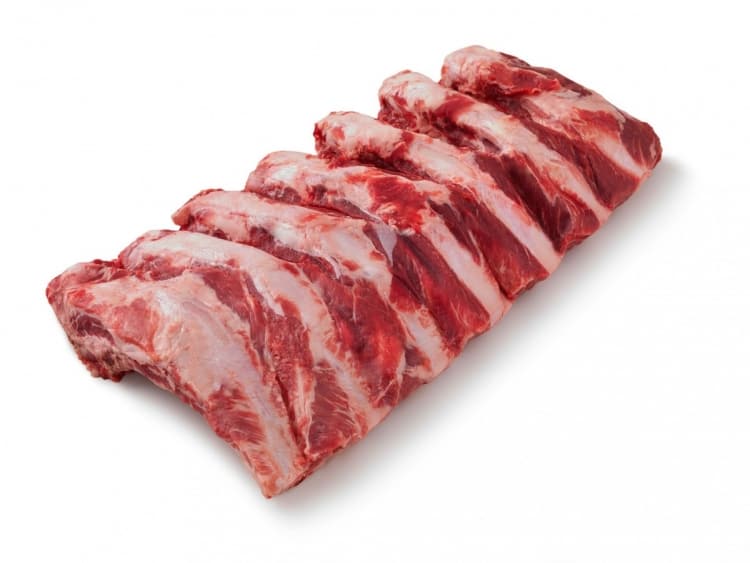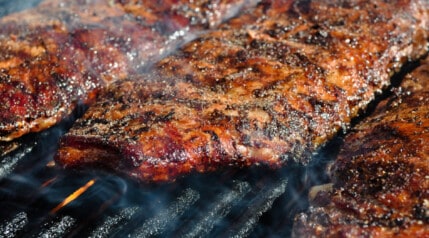
In this article, I’m going to touch on what the different types of beef ribs are, what sets them apart from their pork counterparts we’re more used to, what to tell your butcher when you go shopping and finally, how to cook each type of beef rib.
In just the last couple of years the big, bad beef rib has been making itself known to the barbecue community.
It seems like every day I’m faced with pictures of enormous beef ribs that look more like brisket on a stick than ribs, and would make Fred Flintstone jealous.
But did you know, just like pork, there are a few different types of beef ribs?
Jump to:
What is the Big Deal With Beef Ribs?

As I said, it seems beef ribs are becoming more and more popular these days, but why? What is with the barbecue obsession with the beef rib?
The answer is very simple, and Texas columnist J.C. Reid does an excellent job of summing it up: beef ribs are delicious, photogenic, and primal.
The well-marbled beef rib is packed with flavor (never forget, fat = flavor), and when simply seasoned and smoked at a low temp for a long period, the meat will easily pull away from the bone and melt in your mouth.
On top of that, the large bone of the short plate rib makes for a great Instagram pic that will potentially make the staunchest vegan jealous.
You can click here to follow my method for how to smoke to beef ribs.
Difference Between Beef and Pork Ribs

When we talk about smoking ribs, we’re usually talking about pork, so it’s no surprise that the number one question I hear most about beef ribs is something to the tune of “what makes them different to pork ribs?”
While we go into detail in our look at beef ribs vs pork ribs, the short version is they have their similarities, but they are clearly very different. Most obviously, beef ribs are much larger than all types of pork ribs. This should come as no surprise since a steer is much larger than a hog.
Besides their larger size, beef ribs tend to have more unctuous, gelatinous fat running through them that when rendered down can be like eating brisket on a stick, where the leaner beef back ribs are like eating something like a smokey, rendered steak when cooked just right.
Different Types of Beef Ribs
There are essentially three types of beef ribs:
- Plate Short Ribs (most commonly called beef short ribs.)
- Chuck Short Ribs
- Back Ribs.
The Plate and Chuck ribs typically have more beef than the back ribs, and they are located down towards the stomach of the animal while the back ribs are attached to the prime rib up top.
Plate Short Rib

These are the beef ribs that barbecue pitmasters wet dreams are made of. They are the big honking foot long; melt in your mouth tender, brisket like ribs that you see being cooked in the best barbecue joints in Texas.
According to award-winning author and television host Steven Raichlen, plate ribs are the biggest and beefiest ribs out there with a single bone sometimes weighing as much as 1 – 2.5 pounds.
How to Cook Them
Similar to brisket in their fat content, they will need to be cooked at a low and slow temperature to render the fat down without drying out the meat.
A simple rub of salt and pepper would do wonders for this cut, and it’s an excellent candidate for the smoker.
In the UK, this cut is commonly known as “Jacob’s Ladder” when prepared and cooked with the ribs attached — looking like a ladder.
Chuck Short Rib

Similar to the plate short rib, the chuck short rib is still very meaty, but with just a slightly smaller bone.
This cut will possibly be easier to come by in the supermarket. The ribs will only be 3 – 6 inches long with a rectangle mass of meat on top of the bone. They may also be available boneless or cut into thinner ½” strips.
How to Cook Them
This cut is also very popular in Korean style barbecue and can be marinated in a simple sweet Asian marinade before being grilled over direct heat.
They can also be cooked on a smoker similar to how you would cook plate ribs — just obviously for much less time.
Beef Back Ribs

Back ribs are much different from chuck and plate short ribs. They come from up higher on the cow and are essentially the ribs you would find in a prime rib roast.
Given the fact that prime rib is a very expensive cut of meat, it is no surprise that the butcher will typically try to keep as much meat on the roast as possible.
This means it’s common to find racks of beef back ribs with very little meat on the bones, but with all the meat being only that between the bones.
How to Cook Them
Given their much smaller size, they do well with being cooked indirect on the grill. A little wood smoke can be added but is not necessary.
They will not need to be cooked near as long as plate or chuck ribs, and they do well with a sweet BBQ sauce.
Conclusion
This article was a little short and sweet, but we feel it covers all you could want to know about the more popular cuts of beef ribs.
Do you think we’ve made any glaring omissions? Let us know in the comments and tell us all about how you prepare beef ribs!
Happy grilling!






Since I grew up on pork ribs, I have always been a bit hesitant to work with beef ribs. But, after reading the words, “brisket on a stick”, I literally felt my cheeks pucker and saliva fill my mouth. Too bad I just bought a 14 lb brisket from Costco! I am adding them to the list and will be sure to give them an honest try.
Fantastic site, and thanks for all of this information!
Hi will,
Thanks for the kind words, glad you enjoy the site 🙂
Honestly, I prefer to do beef ribs to brisket a lot of the time. They cook A LOT quicker, tie in with a more predictable cook time, are a good bit more forgiving to any mistake made during the cook, and have a huge ‘wow factor’ to any guests who when you say ‘ribs’, don’t quite expect to see THAT, haha. Also, they are seriously beefy, unctuous, gelatinous in places, full of moisture, and their strong beefy flavor stands up well to and shines through any seriously strong flavors you may decide to use in rubs or sauces, you can really go to town with layering up flavor profiles, and still be able to taste the beef through it all.
Definitely give them a go, then let us know what you think after? Best of luck!
My husband smoked his first plate ribs last night, and it’s my new favorite pit meat. It’s like eating brisket and steak in the same bite! Best way I can describe it is like in the old Reese’s commercials. It’s when chocolate meets peanut butter, the best of both worlds.
Good article. Thanks.
Been dying to try them myself but the price per-pound for something that is half bone makes my lower cheeks pucker. Brisket on a stick at 3 times the price.
I hear ya, but as is true for many ‘premium cuts’, they’re good for an occasional treat.
What’s the difference in taste between short ribs and chuck short ribs?
Hi, Suomynona,
The chuck ribs come from closer to the shoulder end, have more connective tissue and hence when cooked low n slow and those tissues dissolve into collagens, can appear to be more gelatinous, unctuous and moist.
Plate short ribs also tend to have more meat on them and are larger than the chuck ribs.
However, when it comes to taste, the difference isn’t that great and may even be indiscernible after they’ve taken on smoke, perhaps a rub is used, etc. I hope that helps!
Difference between beef spare ribs and beef short ribs? Are the beef spare ribs worth the trouble?
Hi Tom,
I’ve never been able to determine exactly what ‘beef spare ribs’ are, with different butchers and people calling them different things.
Many people tend to say they are ‘back ribs’, which will mean they are mostly bone with just the meat between the bones, as described in the article above , and at Livestrong for example: The Differences in Beef Spare Ribs & Short Ribs
Then we have others who say they are a subset cut from the short rib plate, so they are in fact short ribs. This article from Fischer Bros Butchers: Flanken, Short Ribs & Beef Spare Ribs, has ‘beef spare ribs’ described this way.
So it depends on which definition we accept, and I’ve yet to find a definitive answer for what they actually are.
Please can you tell me what the part is above this beef rib?
It was much tougher than meat next to the bone.
Thanks
Hi Daniel,
I’ve seen that a few times, and actually mentioned it just last week in my write-up of ‘smoked beef ribs’. If you scroll down to the section ‘preparing the ribs’ at this URL: Smoked beef rib recipe
To quote myself from that write up:
“This extra layer of meat is either (commonly believed to be) a piece of brisket — OR — it is the muscle that forms the ‘cap’ on a fore rib of beef. I’m not 100% sure which it is, but either way it cooks differently to the rib meat and must be removed, along with the silverskin between this meat and the rib meat.”
Assuming those are short plate ribs (which they appear to be). The meat closest to the bone is the serratus ventralis – which is heavily marbled and the meat you want to be eating. Above that is a fat seam/silver skin that then separates the “lifter” muscle or the latissimus dorsi. So even more food for thought is that the reason ribs 6-8 are used for Short plate ribs is because the serratus ventalis muscle will begin to fade out into the further ribs on the steer and will essentially be all fat on top of the bone.
Thanks, Mark, I’ve only just stumbled upon your great website — I’ll be spending some time on here having a good read!
Keep up the great work, cheers from the UK.
Thanks, Daniel! Hopefully you find some useful info. I’ll be organizing things a better in a few weeks time, everything’s buried away right now on pages 2…3…9 etc. And hard to find, so I need to build some category page listings of what’s on here. I’t’s on my to-do list (item number 134, haha.)
I’m just wondering if plate ribs are almost exclusively used by restaurants, or can they be found from the supermarket butcher? I’ve never thought about smoking it myself, but if easily available…. I’m drooling!
Thank you, for explaining the different types of beef ribs. Your explanation made it so clear. Now I’ve got to dig out the ribs I’ve got in the freezer to see what type I bought. Beef ribs are on the menu this weekend!
Hi, Kim,
Plate ribs are hard to find on supermarket shelves, but give your local butcher a few days notice, and they will definitely be able to get them for you. Good luck with the cook, let us know how you get on!
I am glad I came across your site explaining the difference. I recently bought some beef ribs from a local market and the butchers swore they were beef after I kept asking if they were.
See … I’ve seen beef ribs at Costco (years ago), and they were huge. This is here in Los Angeles. I haven’t seen plain beef ribs there in a long while to be hones. Now it’s just short ribs.
So having that memory of how big they were I was surprised to be given these ribs that somewhat resembled spare ribs in their size, but there is something different. They’re a little longer on some parts. It’s hard to tell because they’re frozen and there’s some ice on them. I am trying to convince myself I wasn’t taken.
The color does look more beef-like, but some parts still look like pork spares. They’re not thick at all. I was expecting those super thick meaty ones which are strangely hard to find here in Los Angeles. We’ll see once these get cooked.
Hi Tangier,
Let us know what you ultimately bought and how they turn out!
Thank you for the info. I wish there was a picture of what I asked about. I would like to have seen a picture of beef brisket and ribs
Hi Laverne,
That would definitely help! I’m currently updating old(er) content as we speak, and part of that is more images. I will for sure add some in when I get to this one.
I am looking for a braised recipe for what the knowledgeable beef butchers refer to as 1,2 3 ,a flank beef back ribs. I am ends. Guessing that there are 6 ribs to a side. I am flying blind here and would like to find a recipe. Otherwise, I will just come up with something, as I feel ribs and I are good friends. I am definitely not speaking about flanken style short ribs. I am talking about maybe 5 # of ribs, probably 12 ribs. At $10-14.00 per-pound. If you can help. Please help this old flat lander from Illinois.
I ordered a plate from my butcher and smoked them for seven hours on my Weber Professional Series Grill/Smoker and they were ridiculously good. You were right, better than Brisket. I just orders two more plates for the freezer. My butcher has to special order them.
Love it! They’re def one of my favorites.
I have eaten my weight in bed ribs in my lifetime but never knew the difference. And only recently started smoking short ribs myself. Now I can branch out to brisket on a stick and be the smartest rib master in my neighborhood.
God bless you! Wish I would have known this 40 years ago.
Dearest Mark, I know you are speaking to the outdoor Barbecue folks, but I live in an Apt. In Paris. No chance of a smoker or outdoors, but would love to make the meaty barbecue. How can I do so in my oven (regular size)?
Hi, Almeta,
You can follow any BBQ or grilling recipe in your oven for ‘smoking’, and on your hob in a pan for ‘grilling.’ Just follow the same temperatures and times. However, you will miss out on a lot of the flavor imparted by charcoal and wood smoke. To counteract this, look into using ‘liquid smoke’. Stubbs is the most famous brand of this. This will add back some of the flavor you would be missing.
Hope this helps!
Stumbled onto your page and love the content. We just received a 1/4 side of beef and one of the packages was labeled Jose ribs. It’s a lot bigger than our short rib packs, so I have no idea what they are. I can’t find anything called Jose other than restaurants. Any idea?
Hi Kevin,
I’ve honestly never heard of ‘Jose ribs’ I’m afraid. Can you call up the butcher / supplier and ask what they are? They should be happy to help? If you do, can you let us know what they are, as I’m curious too!
I was more interested in the beef flanken ribs which cook up really nice and are not a lot of work. They cook up really good on low in the cast iron skillet 💖🤗😏, no salt, no seasoning at all just the fat that was on it 🤗 , I got them from Whole foods…….they have really good grades of meats and fish…….
I agree with your comparison but when cooked the same, each rib type has its own unique flavor. However, I must say I’ve never compared the 3 ribs from the same side of beef. Someday I’ll attempt to do that.
I generally prefer the chuck ribs when I have the cook time and when time is a factor back ribs, small end only, are delicious.
Your explanation will be shared with butchers/meat cutters that just don’t get it!
Thanks.